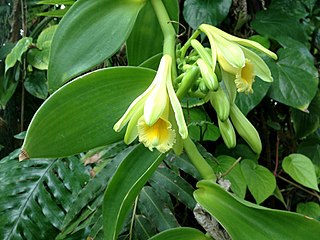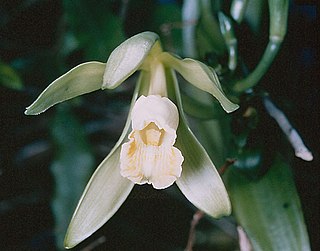
Vanilla is a spice derived from orchids of the genus Vanilla, primarily obtained from pods of the species, flat-leaved vanilla (V. planifolia).

Creosote is a category of carbonaceous chemicals formed by the distillation of various tars and pyrolysis of plant-derived material, such as wood, or fossil fuel. They are typically used as preservatives or antiseptics.

Vanillin is an organic compound with the molecular formula C8H8O3. It is a phenolic aldehyde. Its functional groups include aldehyde, hydroxyl, and ether. It is the primary component of the extract of the vanilla bean. Synthetic vanillin is now used more often than natural vanilla extract as a flavoring in foods, beverages, and pharmaceuticals.

Vanilla extract is a solution made by macerating and percolating vanilla pods in a solution of ethanol and water. It is considered an essential ingredient in many Western desserts, especially baked goods like cakes, cookies, brownies, and cupcakes, as well as custards, ice creams, and puddings. Although its primary flavor compound is vanillin, pure vanilla extract contains several hundred additional flavor compounds, which are responsible for its complex, deep flavor. By contrast, artificial vanilla flavor is solely made up of artificially derived vanillin, which is frequently made from a by-product of the wood pulp industry. Because of the way that vanilla extract is made, there is no possible way for it to be colorless or clear. Therefore, any clear vanilla flavoring is artificial.

Coumarin or 2H-chromen-2-one is an aromatic organic chemical compound with formula C9H6O2. Its molecule can be described as a benzene molecule with two adjacent hydrogen atoms replaced by an unsaturated lactone ring −(CH)=(CH)−(C=O)−O−, forming a second six-membered heterocycle that shares two carbons with the benzene ring. It belongs to the benzopyrone chemical class and considered as a lactone.

Vanilla, the vanilla orchids, forms a flowering plant genus of about 110 species in the orchid family (Orchidaceae). The most widely known member is the flat-leaved vanilla, native to Mexico and Belize, from which commercial vanilla flavoring is derived. It is the only orchid widely used for industrial purposes in flavoring such products as foods, beverages and cosmetics, and is recognized as the most popular aroma and flavor. The key constituent imparting its flavour is the phenolic aldehyde, vanillin.

Ferulic acid is a hydroxycinnamic acid, is an organic compound with the formula (CH3O)HOC6H3CH=CHCO2H. The name is derived from the genus Ferula, referring to the giant fennel (Ferula communis). Classified as a phenolic phytochemical, ferulic acid is an amber colored solid. Esters of ferulic acid are found in plant cell walls, covalently bonded to hemicellulose such as arabinoxylans.
Guaiacol is an organic compound with the formula C6H4(OH)(OCH3). It is a phenolic compound containing a methoxy functional group. Guaiacol appears as a viscous colorless oil, although aged or impure samples are often yellowish. It occurs widely in nature and is a common product of the pyrolysis of wood.

Kaempferol (3,4′,5,7-tetrahydroxyflavone) is a natural flavonol, a type of flavonoid, found in a variety of plants and plant-derived foods including kale, beans, tea, spinach, and broccoli. Kaempferol is a yellow crystalline solid with a melting point of 276–278 °C (529–532 °F). It is slightly soluble in water and highly soluble in hot ethanol, ethers, and DMSO. Kaempferol is named for 17th-century German naturalist Engelbert Kaempfer.

Procyanidins are members of the proanthocyanidin class of flavonoids. They are oligomeric compounds, formed from catechin and epicatechin molecules. They yield cyanidin when depolymerized under oxidative conditions.

Vanillic acid is a dihydroxybenzoic acid derivative used as a flavoring agent. It is an oxidized form of vanillin. It is also an intermediate in the production of vanillin from ferulic acid.
Chemical tests in mushroom identification are methods that aid in determining the variety of some fungi. The most useful tests are Melzer's reagent and potassium hydroxide.

Orcinol is an organic compound with the formula CH3C6H3(OH)2. It occurs in many species of lichens including Roccella tinctoria and Lecanora. Orcinol has been detected in the "toxic glue" of the ant species Camponotus saundersi. It is a colorless solid. It is related to resorcinol, 1,3-C6H4(OH)2.

ortho-Vanillin (2-hydroxy-3-methoxybenzaldehyde) is an organic solid present in the extracts and essential oils of many plants. Its functional groups include aldehyde, ether and phenol. ortho-Vanillin, a compound of the formula C8H8O3, is distinctly different from its more prevalent isomer, meta-vanillin. The "ortho-" prefix refers to the position of the compound’s hydroxyl moiety, which is found in the para-position in vanillin.

The phenolic content in wine refers to the phenolic compounds—natural phenol and polyphenols—in wine, which include a large group of several hundred chemical compounds that affect the taste, color and mouthfeel of wine. These compounds include phenolic acids, stilbenoids, flavonols, dihydroflavonols, anthocyanins, flavanol monomers (catechins) and flavanol polymers (proanthocyanidins). This large group of natural phenols can be broadly separated into two categories, flavonoids and non-flavonoids. Flavonoids include the anthocyanins and tannins which contribute to the color and mouthfeel of the wine. The non-flavonoids include the stilbenoids such as resveratrol and phenolic acids such as benzoic, caffeic and cinnamic acids.

Vanilla is frequently used to flavor ice cream, especially in North America, Asia, and Europe. Vanilla ice cream, like other flavors of ice cream, was originally created by cooling a mixture made of cream, sugar, and vanilla above a container of ice and salt. The type of vanilla used to flavor ice cream varies by location. In North America and Europe consumers are interested in a more prominent, smoky flavor, while in Ireland, a more anise-like flavor is desired. To create the smooth consistency of ice cream, the mixture has to be stirred occasionally and then returned to the container of ice and salt to continue the solidification process. According to Iced: 180 Very Cool Concoctions, many people often consider vanilla to be the "default" or "plain" flavor of ice cream.

Protocatechuic aldehyde is a phenolic aldehyde, a compound released from cork stoppers into wine.

In biochemistry, naturally occurring phenols are natural products containing at least one phenol functional group. Phenolic compounds are produced by plants and microorganisms. Organisms sometimes synthesize phenolic compounds in response to ecological pressures such as pathogen and insect attack, UV radiation and wounding. As they are present in food consumed in human diets and in plants used in traditional medicine of several cultures, their role in human health and disease is a subject of research. Some phenols are germicidal and are used in formulating disinfectants.

Miquelianin is a flavonol glucuronide, a type of phenolic compound present in wine, in species of St John's wort, like Hypericum hirsutum, in Nelumbo nucifera or in green beans.

Vanilla tahitensis is a species of orchid in the genus Vanilla. It was first described by the botanist John William Moore in 1933 from Raiatea in the Society Islands, where it was found growing on trees, having escaped from cultivation.




















